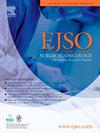Sarcopenia is a negative prognostic factor in localized extremities/trunk wall soft tissue sarcomas
IF 3.5
2区 医学
Q2 ONCOLOGY
引用次数: 0
Abstract
Objective
Sarcopenia is an emerging determinant of oncologic patients’ prognosis, but few data are available in extremities and trunk wall soft tissue sarcomas (ESTS). The aim was to evaluate sarcopenia impact on outcomes of patients affected by ESTS.
Methods
Through SliceOMatic software we selected cross-sectional skeletal muscle area (SMA), subcutaneous fat area (SFA) and visceral fat area (VFA) on a basal CT-slice at level of the third lumbar vertebra. Muscle density (MD) was computed in Hounsfield units (HU).
Skeletal mass index (SMI, cm2/m2) was computed by normalizing SMA for the square of patient's height. Cut-offs for SMI were 52 and 39 cm2/m2 for men and women, respectively, while we used median values for MD, SFA and VFA. We explored the correlation of the different parameters with post-surgical complications and survival outcomes (Kaplan-Meier method).
Results
268 patients were included. Median SMAs, SMIs and MD were 155.7 cm2, 51.2 cm2/m2, and 33.8 HU for men, 91.4 cm2, 39.2 cm2/m2, and 30.4 HU for women. Sarcopenia rate was not significantly higher in patients ≥65 years nor according to baseline prognostic factors (Sarculator app). Overall survival (OS) was significantly worse for sarcopenic patients: median OS 111.7 months (95%CI 72.8–150.6) vs not reached (NR; HR = 1.55, 95%CI:1.00–2.41, p = 0.049) for low-vs high-SMI; median OS 79.6 months (38.6–120.6) vs NR (HR 2.11, 1.34–3.34, p = 0.001) for low-vs high-MD, respectively. Sarcopenic patients showed increased post-surgical complications (30.5 % vs 17.0 %, p = 0.073).
Conclusion
Although retrospective, our study suggests to further explore sarcopenia as a negative prognostic factor in ESTS patients.
求助全文
约1分钟内获得全文
求助全文
来源期刊

Ejso
医学-外科
CiteScore
6.40
自引率
2.60%
发文量
1148
审稿时长
41 days
期刊介绍:
JSO - European Journal of Surgical Oncology ("the Journal of Cancer Surgery") is the Official Journal of the European Society of Surgical Oncology and BASO ~ the Association for Cancer Surgery.
The EJSO aims to advance surgical oncology research and practice through the publication of original research articles, review articles, editorials, debates and correspondence.
 求助内容:
求助内容: 应助结果提醒方式:
应助结果提醒方式:


